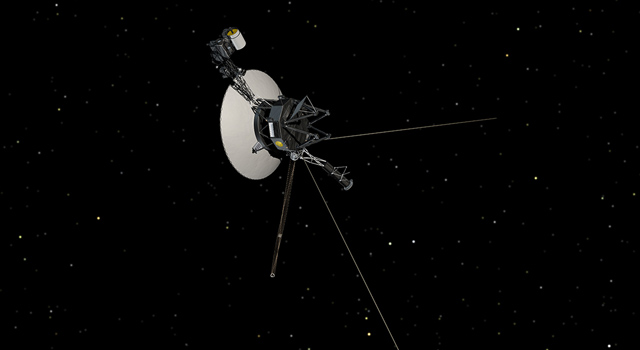News | August 3, 1989
Voyager 2 Reveals Three Additional Neptune Moons

Images from the Voyager 2 spacecraft have revealed three additional new moons in orbit around Neptune, Voyager imaging team scientists announced today.
The discovery brings to six the total of moons known to exist around the blue planet, including one, 1989 N1, discovered by Voyager 2 last month. The spacecraft, launched in 1977, has been to Jupiter, Saturn and Uranus, and will come within 4,850 kilometers (3,000 miles) of Neptune at 9 p.m. (PDT) on Aug. 24, 1989.
Finding so many moons when the spacecraft was more than 22 million miles away from Neptune may mean there are many more to be found in coming weeks, according to Voyager scientists.
The three newest Neptunian satellites, temporarily designated 1989 N2, 1989 N3 and 1989 N4, were tracked as candidate moons in images returned by the spacecraft over five-day period. When the objects were found to follow predicted orbits, Voyager imaging scientists yesterday were able to confirm them as moons of Neptune. Their temporary names designate the order in which they were discovered.
Preliminary calculations indicate the objects may range from 100 to 200 kilometers (about 60 to 125 miles) in diameter.
Like 1989 N1, the three new moons occupy nearly circular and equatorial orbits around the planet. All move in prograde orbits (in the same direction the planet rotates), making the large moon Triton, which occupies retrograde orbit, even more of an oddity in the Neptune system.
The innermost of the new moons is 1989 N3, which orbits at distance of about 52,000 kilometers (32,300 miles) from the center of the planet, or about 27,300 kilometers (about 17,000 miles) from Neptune's cloud tops. It makes one complete orbit of Neptune every 8 hours, 10 minutes.
Next out is 1989 N4, orbiting about 62,000 kilometers from the planet's center, or about 37,300 kilometers (23,300 miles) from the cloud tops. It orbits the planet every 10 hours, 20 minutes.
The outermost is 1989 N2, at about 73,000 kilometers (45,400 miles) from Neptune's center, or about 48,300 kilometers (30,000 miles) from the cloud tops. It makes an orbit every 13 hours, 30 minutes.
All three new moons exist in the region where partial Neptunian rings, or "ring arcs," are thought to exist. If ring arcs exist, the new moons might play an important role in "shepherding" and maintaining them, Voyager scientists said. The search for moons and visible ring arcs will continue as Voyager 2 flies toward Neptune.
Several sequences of spacecraft activity include plans to point Voyager 2's cameras at any newly discovered ring arcs or moons.
The Voyager Mission is conducted by the Jet Propulsion Laboratory, Pasadena, Calif., for NASA's Office of Space Science and Applications.
